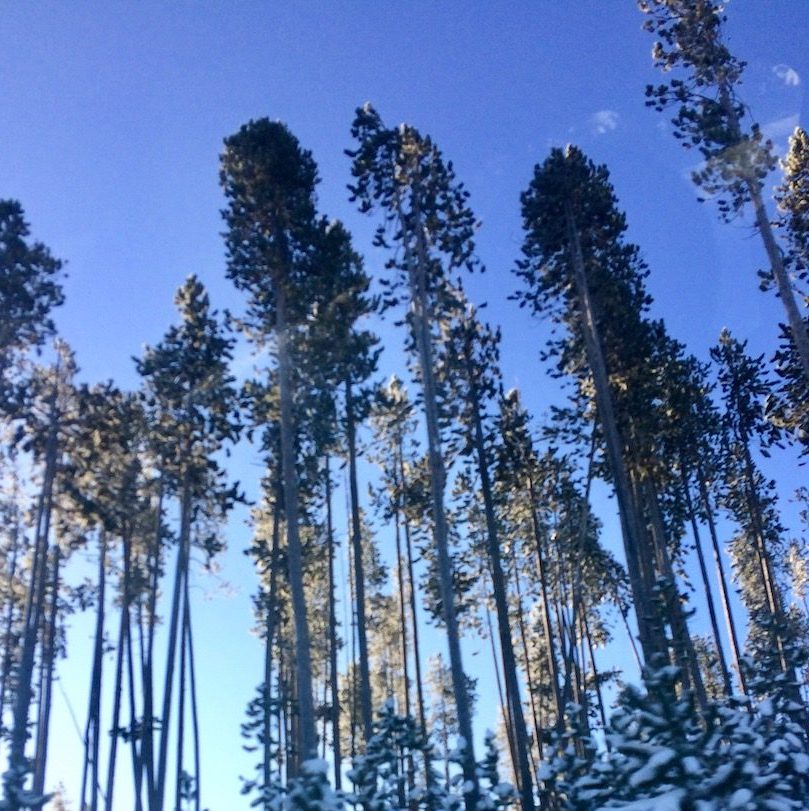
From the trailhead, the narrow, uneven path took us up a short, steep incline between towering pines. The road below and the river beyond were visible between their trunks. Lodgepoles, their growing habits produced tall, straight poles topped by comparatively tiny Christmas trees and created a sheltering canopy over the trail. At the top of the slope the path turned away from the traffic and entered an entirely different forest, this one dense and silent. Here the trees were young and full to the ground—all born from Yellowstone’s Fires of 1988. We walked—my husband and I—side-by-side on an earthen path just wide enough to allow us a glimpse of what lay perpetually ahead: more trees.
We were headed to Gneiss Creek. At least, that was our plan. This was new territory for us.
Unless I have a specific reason to take a particular trail, when given a choice between a new one and a familiar one, I will choose the one I’ve walked before. Almost always, I prefer a familiar path to a novel one. That day, time and location parameters made new the only option.
New trails leave hikers without key internal navigational resources—the ones that mark time and distance. Without them, landmarks mean little and the road seems to stretch on without end. It doesn’t take long before it seems reasonable to wonder if we’ve lost the way. It’s disorienting, especially when the trail is something less than obvious.
New or not, this was my kind of path—dappled, peaceful, well-worn. Without deceptive side paths that lead to a dead end. Free from confusing forks that cast doubt about the way. My husband and I could be confident with every single step.
But then it transformed into something that was not my kind of path. As in, there was no path. Now, all we had were vague instructions to set off into the woods—in this general direction, for this distance, watching for that landmark. All this with the hope that, eventually, we would arrive at the creek.
I don’t easily take to unknown terrain: I prefer the comfort of the familiar. I like to know at the outset how much time and energy will be required, how many hills to expect, and just how steep they will be. A familiar trail’s end I can see at the beginning—at least within the confines of my mind—and I know at the beginning I can handle the journey.
Walking by faith doesn’t work that way because walking that way doesn’t take any faith at all.
Walking by faith is a one step at a time practice. It has nothing to do with what we know about the path ahead. Nothing to do with what we think we can see. It’s all about Who we know.
On a grand scale, we’ve been making our way through familiar, recognizable, and even generally expected terrain. Some sections have been steep, tight, and would easily qualify for trail designations of strenuous or difficult. Others would be tagged as moderate. A few—flat, wide, and maybe a little dappled—could be called easy. Within the landscapes of our own lives, we’ve navigated topography with the same sorts of varying peaks and valleys.
I doubt any of us expected to see anything of the magnitude that’s unfolded in the last few weeks.
We’ve never been here before. We’re all without some of our navigational resources. We have no landmarks to follow, no idea how long it will take to get there, nor exactly where there is.
The circumstances are disorienting and the path is vague—exactly the kind of terrain people like me avoid under the best of conditions. These are not the best of conditions. I doubt I am alone in my desire to return to a more familiar way.
We don’t always take easily to unfamiliar terrain. We aren’t always given a choice about which trail to take, but we do have a choice about how we take it. We may be walking through the valley the shadow of what feels like death, but we don’t walk alone.
While we may not know how long this section of the trail will last or what cost the journey will exact, we do know that our Shepherd leads us not only beside still waters but also in paths of righteousness, that He’s promised to be with us, and that He saves us.
What—and Who—we know about unfamiliar terrain is more important than what we don’t. Let’s navigate according to that. One step at a time.
[bctt tweet=”What—and Who—we know about unfamiliar terrain is more important than what we don’t. Let’s navigate according to that. One step at a time.” username=”N_Ogbourne”]
This has been on my heart a lot recently as I have been blogging through one of my favorite books, A Shepherd Looks at Psalm 23, and meditating on Jesus as the Good Shepherd. He knows the terrain; I do not. My role as his sheep is to trust, obey, and follow after His leading. It is not easy but it is always the best way.
Such timely thoughts. Thanks so much for sharing, Natalie. 🤗 Stopping by from #letshavecoffee
Natalie, you have brought some very wise truths for these days we are in. “Walking by faith … It’s all about Who we know.” And in this I can walk in peace today! Blessings!
Our peace is definitely based on the Who, not the what of our circumstances!